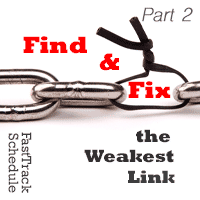 No question, the project budget is critical. Customer funding is based on it, project success is derived from how closely you manage to it, and without it you can’t perform any work on the engagement.
No question, the project budget is critical. Customer funding is based on it, project success is derived from how closely you manage to it, and without it you can’t perform any work on the engagement.
Properly pricing the project – properly estimating the costs that go into the project – is critical for any size engagement. Therefore, it’s always a good time to examine and discuss the elements that go into the overall project budget because as a project manager, you may – if you’re lucky – have some influence of the inputs to the project costs and budget. And it’s a certainty that you’ll be responsible for it – even if you had no input at the beginning of the engagement.
For this project budgeting series, let’s examine the key types of costs that go into the project budget.
The people costs
These are the costs associated with the personnel on the project. They include salaries and the cost of benefits (such as vacation time and health insurance) if they apply. Employee or contractor salaries and expenses are one of the biggest budget items on any project. If you happen to be working for a nonprofit company that is using all volunteers to complete the project work, your salary expenses may be smaller, but you’ll still probably have expenses for subject matter expertise, contractors, the project manager’s salary, and so on.
The administrative costs
Administrative costs are the everyday costs that support the work of the project but are not necessarily directly related to a specific task on the project. Phone expense, copier paper, heating expenses, and support personnel are examples of administrative costs. Project teams have to work and meet somewhere, so that means that there is some sort of facilities expense in the form of rent, lease, or mortgage payments. If the building or facility was leased or purchased specifically for the project, it would be classified as a project cost instead of an administrative cost.
Project resource costs
Resource and project costs include things such as materials needed for specific tasks, equipment leases, travel expenses, and so on. These expenses are specific to the project. For example, if the project consists of building an office building in a prime downtown location, you’ll need the use of a crane during the early phases of the construction to lift the steel beams and other. Resource costs are typically the largest expense for construction projects, and estimating these costs will require research by the project manager and team.
If you as the project manager have initial budget input or responsibility for creating the initial project budget, then careful examination of each of these categories will help you come up with a reasonable budget for the project. If not, being aware will help you identify what may have been missed and it will certainly help you as you manage the project budget on an ongoing basis throughout the engagement.
Direct costs vs. indirect costs
In addition to the three categories of project costs we discussed above, there are also two types of costs: direct and indirect costs. Direct costs include costs such as salaries, equipment rentals, software, and training for team members. Any cost that can be directly attributed to project work is a direct cost.
Direct costs = Cost specifically related to the work of the project.
Indirect costs are not specific to the project. When your project team works with other members of the organization who are not working on the project in the same building, things like the lease cost of the building would be considered an indirect cost because it is not specifically related to the project. Another indirect costs would be administrative staff who will be assisting you with project activities but aren’t assigned specific project tasks themselves.
Indirect costs = Costs associated with the project but not directly related to the work of the project.
Each organization is different, so work with accounting to see how indirect costs should be handled in your project budget.
Gather the docs
The first step in creating the project budget is to gather all the planning documents for reference. You will want to start with a review of the project goals and deliverables for obvious budget expenses. Next, take a look at the task list, the WBS, anything task-wise that you can get your hands on. Record tasks or items that will have costs associated with them on your list. Reviewing the project schedule and associated tasks at this point with your team will help a lot in drafting the overall project budget. But don’t forget to include equipment rentals, facilities, and material expenses associated with tasks and WBS elements.
The budgeting process
The process for creating the budget is similar to identifying the resource requirements and creating the project schedule. Review the planning documents to uncover all the materials and resources you’ll need, estimate their costs, record them in the budget, and finally get approval of the budget. Here are the steps you’ll follow to get your budget process rolling:
- Review the planning documents
- Create cost estimates and integrate them with the project schedule
- Submit the budget for approval to the project sponsor or project committee
- Notify the appropriate project team members and stakeholders when the budget is approved
- Once complete, review the budget every week of the project for needed revisions and accuracies against actuals
Summary
As the project manager, you should go into the project fully equipped to execute the project based on the resources available. In order to accomplish this you need an accurate budget to use as your guideline. This will allow you to manage it better on a week-to-week basis and keep all stakeholders properly informed of the project budget status. It’s not an easy process, but my maintaining control of the budget you’ll have better control of the project.



